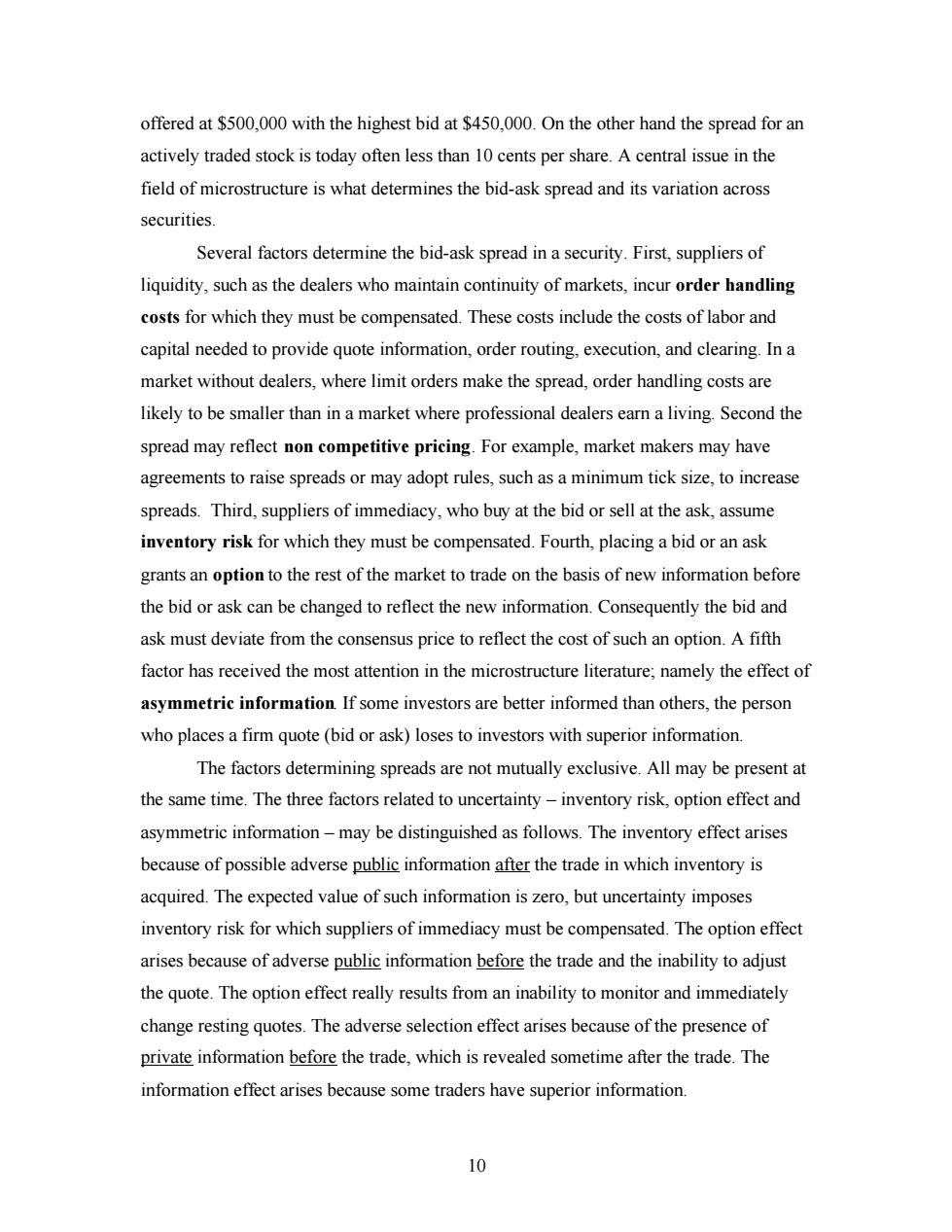正在加载图片...

offered at $500,000 with the highest bid at $450,000.On the other hand the spread for an actively traded stock is today often less than 10 cents per share.A central issue in the field of microstructure is what determines the bid-ask spread and its variation across securities. Several factors determine the bid-ask spread in a security.First,suppliers of liquidity,such as the dealers who maintain continuity of markets,incur order handling costs for which they must be compensated.These costs include the costs of labor and capital needed to provide quote information,order routing,execution,and clearing.In a market without dealers,where limit orders make the spread,order handling costs are likely to be smaller than in a market where professional dealers earn a living.Second the spread may reflect non competitive pricing.For example,market makers may have agreements to raise spreads or may adopt rules,such as a minimum tick size,to increase spreads.Third,suppliers of immediacy,who buy at the bid or sell at the ask,assume inventory risk for which they must be compensated.Fourth,placing a bid or an ask grants an option to the rest of the market to trade on the basis of new information before the bid or ask can be changed to reflect the new information.Consequently the bid and ask must deviate from the consensus price to reflect the cost of such an option.A fifth factor has received the most attention in the microstructure literature;namely the effect of asymmetric information.If some investors are better informed than others,the person who places a firm quote(bid or ask)loses to investors with superior information The factors determining spreads are not mutually exclusive.All may be present at the same time.The three factors related to uncertainty-inventory risk,option effect and asymmetric information-may be distinguished as follows.The inventory effect arises because of possible adverse public information after the trade in which inventory is acquired.The expected value of such information is zero,but uncertainty imposes inventory risk for which suppliers of immediacy must be compensated.The option effect arises because of adverse public information before the trade and the inability to adjust the quote.The option effect really results from an inability to monitor and immediately change resting quotes.The adverse selection effect arises because of the presence of private information before the trade,which is revealed sometime after the trade.The information effect arises because some traders have superior information. 1010 offered at $500,000 with the highest bid at $450,000. On the other hand the spread for an actively traded stock is today often less than 10 cents per share. A central issue in the field of microstructure is what determines the bid-ask spread and its variation across securities. Several factors determine the bid-ask spread in a security. First, suppliers of liquidity, such as the dealers who maintain continuity of markets, incur order handling costs for which they must be compensated. These costs include the costs of labor and capital needed to provide quote information, order routing, execution, and clearing. In a market without dealers, where limit orders make the spread, order handling costs are likely to be smaller than in a market where professional dealers earn a living. Second the spread may reflect non competitive pricing. For example, market makers may have agreements to raise spreads or may adopt rules, such as a minimum tick size, to increase spreads. Third, suppliers of immediacy, who buy at the bid or sell at the ask, assume inventory risk for which they must be compensated. Fourth, placing a bid or an ask grants an option to the rest of the market to trade on the basis of new information before the bid or ask can be changed to reflect the new information. Consequently the bid and ask must deviate from the consensus price to reflect the cost of such an option. A fifth factor has received the most attention in the microstructure literature; namely the effect of asymmetric information. If some investors are better informed than others, the person who places a firm quote (bid or ask) loses to investors with superior information. The factors determining spreads are not mutually exclusive. All may be present at the same time. The three factors related to uncertainty – inventory risk, option effect and asymmetric information – may be distinguished as follows. The inventory effect arises because of possible adverse public information after the trade in which inventory is acquired. The expected value of such information is zero, but uncertainty imposes inventory risk for which suppliers of immediacy must be compensated. The option effect arises because of adverse public information before the trade and the inability to adjust the quote. The option effect really results from an inability to monitor and immediately change resting quotes. The adverse selection effect arises because of the presence of private information before the trade, which is revealed sometime after the trade. The information effect arises because some traders have superior information